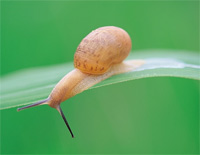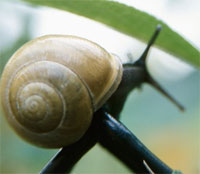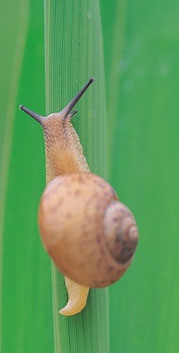|

 Stretching snails: Snails move like earthworms by alternating body contractions with
stretching, with a proverbially low speed. They produce mucus
in order to aid locomotion by reducing friction. The mucus also
reduces the snail's risk of injury and helps keep away potentially
dangerous insects like ants. When retracted into their shells,
snails secrete a special type of mucus which dries to cover the
entrance of their shells with a 'trapdoor' like structure called
an operculum. This is similar to some slug species which build
a shell-like object below their upper skin to prevent drying out.
The operculum of some snails has a pleasant scent when burned,
so it is sometimes used as an ingredient in incense. Stretching snails: Snails move like earthworms by alternating body contractions with
stretching, with a proverbially low speed. They produce mucus
in order to aid locomotion by reducing friction. The mucus also
reduces the snail's risk of injury and helps keep away potentially
dangerous insects like ants. When retracted into their shells,
snails secrete a special type of mucus which dries to cover the
entrance of their shells with a 'trapdoor' like structure called
an operculum. This is similar to some slug species which build
a shell-like object below their upper skin to prevent drying out.
The operculum of some snails has a pleasant scent when burned,
so it is sometimes used as an ingredient in incense.
 Shell hibernation: In winter or in dry seasons, some snail species hibernate in
their shells by building the operculum, which is for protection
while hibernating and which is destroyed in spring or when their
surroundings becomes wetter. Some species gather and hibernate
in groups while others bury themselves before hibernating. Shell hibernation: In winter or in dry seasons, some snail species hibernate in
their shells by building the operculum, which is for protection
while hibernating and which is destroyed in spring or when their
surroundings becomes wetter. Some species gather and hibernate
in groups while others bury themselves before hibernating.
All shapes and sizes: Snails come in a range of sizes. The largest land snail is the
Giant African Snail (Achatina achatina; Family Achatinidae), which
can measure up to 30 cm. Pomacea maculata (Family Ampullariidae),
or Giant Apple Snail is the largest freshwater snail, with its
size  reaching 15 cm diameter and over 600 g weight. The biggest
of all snails is Syrinx aruanus, a marine species living in Australia. reaching 15 cm diameter and over 600 g weight. The biggest
of all snails is Syrinx aruanus, a marine species living in Australia.
Snail grows=shell grows: As the snail grows, so do their shells. A snail will close off a section of its shell and add a new chamber as it grows, each
chamber being larger than the previous one by a constant factor.
As a result, the shells forms a logarithmic spiral. At some point,
the snail builds a lip around the opening of the shell, stops
growing, and begins reproducing.
Calcium-essential to a healthy diet: Snail shells and egg casings are made up of primarily calcium
carbonate like other mollusk's shells. Because of this, they require
a decent amount of calcium in their diet and watery environment
to produce a strong shell. A lack of calcium, or a fluctuation
in pH level in their surroundings, would likely cause their shells
to be thin, crack, or have holes. Usually a snail can repair its
shell damage over time if their living conditions improve, but
some damage could be severe enough to be fatal for the snail. Snails hibernate during the winter (typically October through
April). They may also hibernate in the summer in drought conditions
when it is known as aestivation.
 Hemaphrodites: Some snails are hermaphrodites, producing both spermatozoa and
ova. Others, such as Apple Snails, are either male or female.
Prolific breeders, snails in pairs inseminate each other to internally
fertilize their ova. Each brood may consist of up to 100 eggs. Hemaphrodites: Some snails are hermaphrodites, producing both spermatozoa and
ova. Others, such as Apple Snails, are either male or female.
Prolific breeders, snails in pairs inseminate each other to internally
fertilize their ova. Each brood may consist of up to 100 eggs.

 Many predators: Snails have many natural predators, including decollate snails, ground beetles, snakes, toads, turtles, and birds like chickens,
ducks and geese, and even a predatory caterpillar. Many predators: Snails have many natural predators, including decollate snails, ground beetles, snakes, toads, turtles, and birds like chickens,
ducks and geese, and even a predatory caterpillar.
Danger- humans!! Humans also pose great dangers to snails. Besides the obvious
threat of stepping on them or putting salt on the fleshy body
part, water pollution and acid rain destroy their shells and poison
them, causing many species of snails to become extinct. In addition,
snails are used as human food (often known as escargot) in Europe,
Asia and Africa.
All text is available under the
terms of the GNU Free Documentation License
|